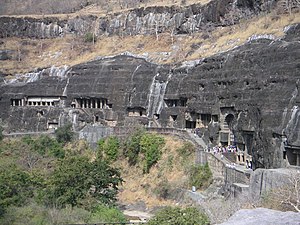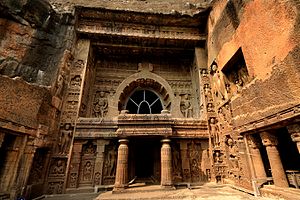
Back أجانتا Arabic كهوف اجانتا ARZ অজন্তা গুহাসমূহ Assamese Аджанта Byelorussian Аджанта Bulgarian অজন্তা গুহাসমূহ Bengali/Bangla Coves d'Ajanta Catalan Аджанта CE Ajanta Caves CEB Adžanta Czech
| UNESCO World Heritage Site | |
|---|---|
 The Ajanta Caves | |
| Location | Ajanta, Aurangabad district, Maharashtra, India |
| Criteria | Cultural: i, ii, iii, vi |
| Reference | 242 |
| Inscription | 1983 (7th Session) |
| Area | 8,242 ha |
| Buffer zone | 78,676 ha |
| Coordinates | 20°33′12″N 75°42′01″E / 20.55333°N 75.70028°E |

| Pilgrimage to |
| Buddha's Holy Sites |
|---|
 |
The Ajanta Caves are 30 rock-cut Buddhist cave monuments dating from the second century BCE to about 480 CE in Aurangabad district of Maharashtra state in India.[1][2][3] Ajanta Caves are a UNESCO World Heritage Site.[2] Universally regarded as masterpieces of Buddhist religious art, the caves include paintings and rock-cut sculptures described as among the finest surviving examples of ancient Indian art, particularly expressive paintings that present emotions through gesture, pose and form.[4][5][6]
The caves were built in two phases, the first starting around the second century BCE and the second occurring from 400 to 650 CE, according to older accounts, or in a brief period of 460–480 CE according to later scholarship.[7]
The Ajanta Caves constitute ancient monasteries (Viharas) and worship-halls (Chaityas) of different Buddhist traditions carved into a 75-metre (246 ft) wall of rock.[8][9] The caves also present paintings depicting the past lives [10] and rebirths of the Buddha, pictorial tales from Aryasura's Jatakamala, and rock-cut sculptures of Buddhist deities.[8][11][12] Textual records suggest that these caves served as a monsoon retreat for monks, as well as a resting site for merchants and pilgrims in ancient India.[8] While vivid colours and mural wall paintings were abundant in Indian history as evidenced by historical records, Caves 1, 2, 16 and 17 of Ajanta form the largest corpus of surviving ancient Indian wall-paintings.[13]

The Ajanta Caves are mentioned in the memoirs of several medieval-era Chinese Buddhist travellers.[14] They were covered by jungle until accidentally "discovered" and brought to Western attention in 1819 by a colonial British officer Captain John Smith on a tiger-hunting party.[15] The caves are in the rocky northern wall of the U-shaped gorge of the River Waghur,[16] in the Deccan plateau.[17][18] Within the gorge are a number of waterfalls, audible from outside the caves when the river is high.[19]
- ^ "Padmapani Painting Ajanta Cave". Chatrapati Sambhajinagar District Administration, Government Of Maharashtra. Archived from the original on 2 April 2023. Retrieved 2 April 2023.
- ^ a b Centre, UNESCO World Heritage. "Ajanta Caves". UNESCO World Heritage Centre. Retrieved 30 March 2023.
- ^ Gopal, Madan (1990). K.S. Gautam (ed.). India through the ages. Publication Division, Ministry of Information and Broadcasting, Government of India. p. 173.
- ^ Ring, Trudy; Watson, Noelle; Schellinger, Paul (2012). Asia and Oceania. Routledge. pp. 17, 14–19. ISBN 978-1-136-63979-1.
- ^ Honour, Hugh; Fleming, John (2005). A World History of Art. Laurence King. pp. 228–230. ISBN 978-1-85669-451-3.
- ^ Michell 2009, p. 336.
- ^ Ajanta Caves: Advisory Body Evaluation, UNESCO International Council on Monuments and Sites. 1982. Retrieved 27 October 2006. Archived 22 December 2009 at the Wayback Machine, p. 2.
- ^ a b c Cite error: The named reference
Johnston2013p18was invoked but never defined (see the help page). - ^ Jamkhedkar, Aravinda Prabhakar (2009). Ajanta. Oxford University Press. pp. 61–62, 71–73. ISBN 978-0-19-569785-8.
- ^ "Ajanta Caves, India: Brief Description, UNESCO World Heritage Site. Retrieved 27 October 2006". Archived from the original on 18 December 2008. Retrieved 26 December 2019.
- ^ Cohen, Richard S. (May 1998). "Nāga, Yakṣiṇī, Buddha: Local Deities and Local Buddhism at Ajanta". History of Religions. 37 (4). University of Chicago Press: 360–400. doi:10.1086/463514. JSTOR 3176402. S2CID 162226757.
- ^ Behl, Benoy K.; Nigam, Sangitika (1998). The Ajanta caves: artistic wonder of ancient Buddhist India. Harry N. Abrams. pp. 164, 226. ISBN 978-0-8109-1983-9.
- ^ Harle 1994, pp. 355–361, 460.
- ^ Cohen 2006a, pp. 32, 82.
- ^ Spink 2007, pp. 3, 139.
- ^ variously spelled Waghora or Wagura
- ^ Map of Ajanta Caves Archived 6 November 2021 at the Wayback Machine, UNESCO
- ^ Sanyal, Narayan (1984). Immortal Ajanta. Bharati. p. 7.
- ^ Spink 2007, p. 2.

